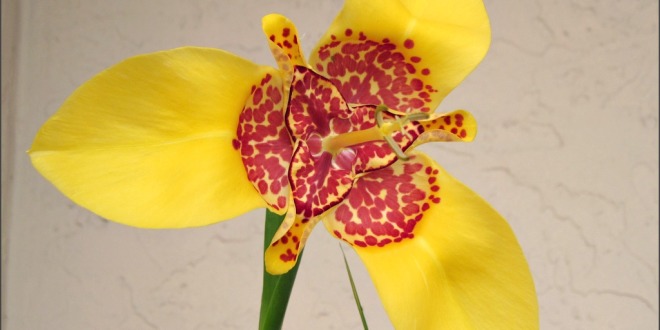Introduction
Tigridia pavonia, commonly known as the Tiger Flower, is a stunning bloomer that adds a touch of tropical beauty to any garden. Whether you’re planting it as an annual or cultivating it as a multiseason perennial, Tigridia pavonia is sure to captivate with its vibrant colors and unique markings. In this comprehensive guide, we’ll cover everything you need to know about growing and caring for these eye-catching flowers.
What Are Tiger Flowers?
Tigridia pavonia belongs to the Iridaceae family, alongside irises, gladiolus, and crocuses. Native to Guatemala, Honduras, Mexico, and El Salvador, it has also naturalized in Ecuador and Peru. Here are some key features of this beautiful flower:
- Appearance: Tiger flowers reach heights of 18 to 24 inches and spread 12 to 18 inches. Their three- to six-inch blooms consist of three larger petals and three smaller ones. The inner petals are speckled with striking dots, while the outer petals display solid, patternless colors.
- Blooming Period: Each bloom lasts for a single day, but multiple buds ensure continuous flowering throughout the two- to four-week bloom period, which usually begins around midsummer.
- Leaves: Narrow, sword-shaped leaves emerge from the plant’s base, providing a verdant backdrop for the flowers.
- Corms: Unlike true bulbs, Tigridia pavonia grows from corms. These small corms are edible when cooked and have a sweet, floury texture.
How to Grow Tigridia pavonia
Follow these steps to grow your own tiger flowers:
- Site Selection:
- Plant tiger flower bulbs in well-drained soil.
- Choose a full sun location, as they thrive in bright sunlight.
- Strong afternoon sun is a plus.
- Planting:
- Plant the bulbs in spring after the last frost.
- Space them 6 to 8 inches apart.
- Plant them 3 to 4 inches deep.
- Watering:
- Keep the soil consistently moist during the growing season.
- Water deeply but avoid waterlogged conditions.
- Maintenance:
- Deadhead spent blooms to encourage continuous flowering. CAUTION: The first flower will die and the next day a new flower will start opening on the same stalk.
- Mulch around the plants to retain moisture and suppress weeds.
- In colder climates, dig up the corms after the first frost and store them in a frost-free place for winter.
Cultivars and Best Uses
- Cultivars: Look for cultivars with various flower colors, including yellow, red, purple, and white.
- Best Uses:
- Plant tiger flowers in borders, containers, or mixed beds.
- They also make excellent cut flowers for arrangements.
Conclusion
Tigridia pavonia is a low-maintenance, visually striking addition to any garden. Whether you’re a seasoned gardener or a beginner, these tiger flowers are sure to impress with their exotic beauty and vibrant hues. Happy gardening! 🌸
For more information, check out these resources:
- How to Grow and Care for Tiger Flowers by Joe Butler1
- Growing Tigridia (Tiger Flower Bulbs)2
- Tigridia pavonia (Tiger Flower)3
Remember to enjoy the fleeting beauty of each tiger flower bloom – like a brief but passionate romance in your garden!








